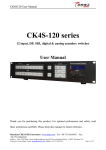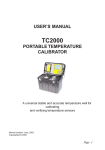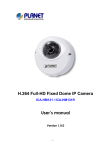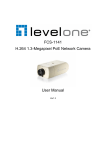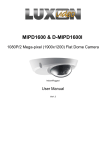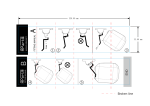Download 1.3 Megapixel Compact IP Dome Camera User`s Manual
Transcript
1.3 Megapixel Compact IP Dome Camera User’s Manual Ver1.4 Table of Contents 1. 2. Software Version ........................................................................................................3 Introduction.................................................................................................................4 2.1 Features.............................................................................................................4 2.2 Package Contents..............................................................................................5 2.3 Camera Overview ..............................................................................................5 3. Preparations for IP Camera Setup ............................................................................7 3.1 System Requirements........................................................................................7 3.2 Ethernet Connection ..........................................................................................7 4. 5. Accessing Camera .....................................................................................................9 Configuration & Operation.......................................................................................16 5.1 Browser-based Viewer Introduction .................................................................16 5.2 Home Page ......................................................................................................18 5.3 System Related Settings..................................................................................19 5.3.1 Host Name and System Time Setting................................................20 5.3.2 Security..............................................................................................21 5.3.3 Network .............................................................................................23 5.3.4 DDNS ................................................................................................26 5.3.5 Mail ....................................................................................................27 5.3.6 FTP....................................................................................................28 5.3.7 Motion Detection................................................................................29 5.3.8 Snapshot ...........................................................................................31 5.3.9 Iris Adjustment (Box Camera and Vandal Proof Dome).....................32 5.4 5.5 5.3.10 View Log File .....................................................................................33 5.3.11 View User Information .......................................................................34 5.3.12 View Parameters ...............................................................................36 5.3.13 Factory Default ..................................................................................37 5.3.14 Software Version ...............................................................................38 5.3.15 Software Upgrade..............................................................................39 Video and Audio Streaming Settings ...............................................................42 5.4.1 Video Resolution and Rotate Type ....................................................42 5.4.2 Video Compression ...........................................................................44 5.4.3 Video OCX Protocol...........................................................................45 5.4.4 Video Frame Skip ..............................................................................46 5.4.5 Privacy Masking Function..................................................................47 5.4.6 Audio Setting .....................................................................................49 Camera Settings ..............................................................................................50 5.5.1 Exposure Setting ...............................................................................50 5.5.2 White Balance Setting .......................................................................51 1 5.6 5.5.3 Backlight Setting ................................................................................52 5.5.4 Brightness Setting..............................................................................52 5.5.5 Sharpness Setting .............................................................................53 5.5.6 Contrast Setting .................................................................................53 5.5.7 Digital Zoom Setting ..........................................................................53 Logout ..............................................................................................................54 6. CMS Software Introduction......................................................................................55 Appendix A: Technical Specifications ...........................................................................56 Appendix B: Internet Security Settings .........................................................................58 Appendix C: DC Viewer Download Procedure ..............................................................61 2 1. Software Version The Compact IP Dome Camera’s current software version is as follows: Time Released Version Oct., 2012 p20091016PS 3 2. Introduction The 1.3 Megapixel Compact IP Dome Camera features a 1/3.8” Sony Progressive CMOS Sensor and generates excellent image quality. Having excellent high definition image quality in low-light conditions, this camera could identify the individuals and objects of interest easily. With Power over Ethernet (IEEE 802.3af) feature, the need of power outlets could be totally eliminated; likewise installation and cabling cost would be significantly reduced. The IP Dome Camera’s flat and sophisticated design enhances more application possibilities, such as indoor/outdoor and mobile surveillance. Additionally, its light weight and compact size offer quick and simple installation on the ceilings or walls of houses and vehicles. 2.1 Features • 1/3.8” 1.3M progressive CMOS • Simultaneous MPEG-4 and MJPEG video stream (dual stream) • Resolution: MPEG-4 VGA,QVGA,CIF,QCIF MJPEG 1280 x 960(4 VGA), VGA, QVGA, CIF, QCIF • Frame Rate: MPEG-4 30fps@VGA; MJPEG 15fps@1280 x 960 • Image Setting: Rotation: Flip, Mirror, and 180∘Rotate Brightness, Sharpness, Contrast, White Balance, Exposure Control Digital Zoom: x1 ~ x12 • Audio Compression: G.711 PCM 64 kbit/s G.726 ADPCM 32 or 24 kbit/s • • • • 4 Shutter Speed: 1.5~1/15000 sec Interface: 10/100 Ethernet Compact Size Dome Cover and Housing Power over Ethernet 2.2 Package Contents Please check the package contains the following items listed below. Security Torx Indoor Camera/ Rugged Camera (with Cable ) Quick Guide 2.3 CD Camera Overview Designation Description 1 Reset Button Restore to default setting; press the button with a proper tool 2 Lens Rotate the lens right/left to adjust focus 3 Focus Fixed Screw Loosen the screw to adjust the lens 4 Tilt Fixed Screw Loosen the screw to adjust tilt angle 5 Dimensions 6 3. Preparations for IP Camera Setup This chapter outlines information about system requirements for IP Dome Camera operation, power and Ethernet connection for Indoor/Outdoor IP Dome Camera, and access to the camera. 3.1 System Requirements To perform the IP Dome Camera via web browser, please ensure your PC is in good network connection, and meet system requirements as described below. Items Minimum Requirement 1. Intel Pentium IV, 3 GHz or higher, Intel Core2 Duo, 2 Personal Computer GHz or higher 2. 1 GB RAM or more 3. AGP graphics card 64 MB RAM, Direct Draw 3.2 Operating System Windows VISTA or Windows XP Web Browser Microsoft Internet Explorer 6.0 or later Network Card 10Base-T (10 Mbps) or 100Base-TX (100 Mbps) operation Viewer ActiveX control plug-in for Microsoft IE Ethernet Connection Please follow the instructions below to connect Indoor/Rugged IP Dome Camera’s Ethernet cable. Indoor Camera PoE Connection Connect the one end of the PoE cable to the Ethernet port on the camera, and the other end to Power Sourcing Equipment (PSE) like hubs or routers. 7 Check the status of the link indicator and activity indicator LEDs; if the LEDs are unlit, please check the connections. Green Link Light indicates good network connection. Orange Activity Light flashes for network activity indication. Rugged Camera M12 D-Coded Connector PoE Waterproof Switch M12 D-Coded Connection For the Rugged IP Dome Camera, connect its Ethernet cable to a M12 waterproof switch as shown above. NOTE: Please use a PoE waterproof switch/hub so that the camera can work. M12 D-Coded Connector’s Pin Definition Pin 1: Rx+ Pin 2: Tx+ Pin 3: Rx- Pin 4: Tx- 8 4. Accessing Camera For initial access to the IP Dome Camera, users can search the camera through the installer program: DeviceSearch.exe, which can be found in “DeviceSearch” folder in the supplied CD. Device Search Software Setup Step 1: Double click on the program Device Search.exe (see the icon below); its window will appear as shown below. Then click the “Device Search” button. Step 2: The security alert window will pop up. Click “Unblock” to continue. 9 Device Search Step 3: Click “Device Search” again, and all the finding IP devices will be listed in the page, as shown in the figure below. The IP Dome Camera’s default IP address is: 192.168.0.250. Step 4: Double click or right click and select “Browse” to access the camera directly via web browser. Step 5: Then the prompt window of request for entering default username and password (as shown below) will appear for logging in to the IP Dome Camera. 10 The default login ID and password for the Administrator are: Login ID Password Admin 1234 NOTE: ID and password are case sensitive. NOTE: It is strongly advised that administrator’s password be altered for the security concerns. Refer to section 5.3.2 Security for further details. Additionally, users can change the IP Dome Camera’s network property, either DHCP or Static IP directly in the device finding list. Refer to the following section for changing the IP Dome Camera’s network property. Example of Changing IP Dome Camera’s Network Property Users can directly change an IP Dome Camera’s network property, ex. from static IP to DHCP, in the finding device list. The way to change the IP Dome Camera’s network property is specified below: Step 1: In the finding device list, click on the IP Dome Camera that you would like to change its network property. On the selected item, right click and select “Network Setup.” Meanwhile, record the IP Dome Camera’s MAC address, for future identification. Step 2: The “Network Setup” page will come out. Select “DHCP,” and press “Apply” button down the page. 11 Step 3: Click “OK” on the Note of setting change. Wait for one minute to re-search the IP Dome Camera. Step 4: Click the “Device Search” button to re-search all the devices. Then select the IP Dome Camera with the correct MAC address. Double click on the IP Dome Camera, and the login window will come out. 12 Step 5: Enter User name and Password to access the IP Dome Camera. Installing DC Viewer Software Online For the initial access to the IP Dome Camera, a client program, DC Viewer, will be automatically installed to your PC when connecting to the IP Dome Camera. If the Web browser doesn’t allow DC Viewer installation, please check the Internet security settings or ActiveX controls and plug-ins settings (see Appendix B: Internet Security Settings) to continue the process. The Information Bar (just below the URL bar) may come out and ask for permission to install the ActiveX Control for displaying video in browser (see the figure below). Right click on the Information Bar and select “Install ActiveX Control…” to allow the installation. 13 Then the security warning window will pop up. Click “Install” to carry on software installation. Click “Finish” to close the DC Viewer window when download is finished. For the detailed software download procedure, please refer to Appendix C: DC Viewer Download Procedure. Once login to the IP Dome Camera, users will see the Home page as shown below: Administrator/User Privileges “Administrator” represents the person who can configure the IP Dome Camera and authorize users access to the camera; “User” refers to whoever has access to the camera with limited authority, i.e. entering Home and Camera setting pages. Lens Adjustment The image displays on the Home page when successfully accessing to the IP Dome Camera. Adjust the camera’s focus to produce a clear image. Please refer to the procedure below. 14 Step 1: Unscrew the IP Dome Camera’s cover. Step 2: Loosen the focus fixed screw, and rotate the lens counter-/clockwise to adjust focus; loosen the tilt fixed screw, and adjust the camera’s tilt angle. 15 5. Configuration & Operation The IP Dome Camera is provided with a user-friendly browser-based configuration interface, and a free bundled CMS (Central Management System) for record and playback video. In this chapter, information about main page introduction, system related settings and camera settings will be described in detail. For further information about CMS software, please refer to Chapter 6. CMS Software Introduction and CMS user manual. 5.1 Browser-based Viewer Introduction The figure below shows the main page of the IP Dome Camera user interface. At the bottom of the main page, users can adjust video display size (x1, x1/2 and full screen), select a kind of video format (MPEG-4 and MJPEG) and save MJPEG snapshots (see 5.3.8 Snapshot). 16 There are five tabs: Home, System, Streaming, Camera and Logout on the top panel. Home Users can monitor live video of the targeted area. System setting Administrator can set host name, system time, root password, network related settings, etc. Further details will be interpreted in section 5.3 System Related Settings. Streaming setting Administrator can modify video resolution and rotate type and select audio compression mode in this page. Camera setting Users can adjust various camera parameters, including <Exposure>, <White Balance>, <Brightness>, <Sharpness>, <Contrast> and <Digital Zoom>. Logout Click on the tab to relogin the IP Dome Camera with another username and password. 17 5.2 Home Page In the Home page, there are several function buttons right down the displayed image. Screen Size Adjustment Image display size can be adjusted to x1/2 and full screen. Digital Zoom Control In the full screen mode, users can implement digital PTZ by right clicking the mouse, rotating the mouse wheel (for zoom in/out), and drag the mouse into any direction. Snapshot Press the button, and the MJPEG snapshots will automatically be saved in the appointed place. The default place of saving snapshots is: C:\. 18 5.3 System Related Settings The figure below shows all categories under the “System” tab. Each category in the left column will be explained in the following sections. NOTE: The “System” configuration page is only accessible by Administrator. 19 5.3.1 Host Name and System Time Setting Press the first category: <System> in the left column; the page is shown as below. Host Name The name is for camera identification. If Motion Detection function (see 5.3.7 Motion Detection) is enabled and is set to send alarm message by Mail/FTP, the host name entered here will display in the alarm message. Sync With Computer Time Select the item, and video date and time display will synchronize with the PC’s. Manual The Administrator can set video date, time and day manually. Entry format should be identical with that shown next to the enter field. 20 5.3.2 Security Click the category: <Security>, and the page is shown as the figure below. Root password Change the administrator’s password by inputting the new password in both text boxes. The input characters/numbers will be displayed as dots for security purposes. After clicking <Save>, the web browser will ask the Administrator for the new password for access. The maximum length of the password is 14 digits. NOTE: The following characters are valid: A-Z, a-z, 0-9, !#$%&’-.@^_~. Add user Type the new user's name and password and click <Add> to add the new user. Both user name and password can be up to 16 characters. The new user will be displayed in the user name list. There is a maximum of twenty user accounts. Each user can be assigned the privileges of “Camera control” and/or “Listen”. 21 • I/O access This item supports fundamental functions that enable users to view video when accessing to the camera. • Camera control This item allows the appointed User to change camera parameters on the Camera Setting page. • Talk/Listen Talk and Listen functions allow the appointed user in the local site (PC site) communicating with, for instance, the administrator in the remote site. NOTE: The IP Mini Fixed Dome Camera does not have Talk function. Manage User Delete user To delete a user, pull down the user list, and select the user name you wish to delete. Then click <Delete> to remove it. Edit user Pull down the user list and select a user name. Click <Edit> to edit the user’s password and privilege. NOTE: It is required to enter the User password as well as select the function open to the user. When finished, click <Save> to modify the account authority. 22 NOTE: The Compact IP Dome Camera does not have Talk function. 5.3.3 Network Click <Network> in the left column, and the page will display as shown below. 23 Users can choose to use fixed IP address or dynamic (DHCP) IP address. The following is descriptions for the two ways of setting IP address. Get IP address automatically (DHCP) The camera’s default setting is “Use fixed IP address”. Please refer to the previous section Chapter 4. Accessing Camera for logging in with the default IP address. If select “Get IP address automatically”, after the IP Dome Camera restarts, users can search it through the installer program: DeviceSearch.exe, which can be found in “DeviceSearch” folder in the supplied CD. NOTE: Please make the record of the IP Dome Camera’s MAC address, which can be found in the label of the camera, for identification in the future. Use fixed IP address To setup static IP address, select “Use fixed IP address” and move the cursor to the IP address blank (as indicated below) and insert the new IP address, ex. 192.168.7.234; then go to the Default gateway (explained latter) blank and change the setting, ex. 192.168.7.254. Press “Save” to confirm the new setting. 24 When using static IP address to login to the IP Dome Camera, users can access it either through “DeviceSearch” software (see Chapter 4. Accessing Camera) or input the IP address in the URL bar and press “Enter”. General • IP address This is necessary for network identification. • Subnet mask It is used to determine if the destination is in the same subnet. The default value is “255.255.255.0”. • Default gateway This is the gateway used to forward frames to destinations in different subnet. Invalid gateway setting will fail the transmission to destinations in different subnet. • Primary DNS Primary DNS is the primary domain name server that translates hostnames into IP addresses. • Secondary DNS Secondary DNS is a secondary domain name server that backups the primary DNS. • Web Server port Web server port could be set from 1 to 65535. Advanced • RTSP port RTSP port could be set from 1 to 65535. (Normal Setting Port: 554, 1024 ~65535) NOTE: Be aware to choose the different port from the one set for the web server port. 25 5.3.4 DDNS Dynamic Domain Name System (DDNS) allows a DNS name to be constantly synchronized with a dynamic IP address. In other words, it allows those using a dynamic IP address to be associated to a static domain name so others can connect to it by name. Enable DDNS Check the item to enable DDNS. Provider Select one DDNS host from the provider list. Host name Enter the registered domain name in the field. Username/E-mail Enter the username or e-mail required by the DDNS provider for authentication. 26 Password/Key Enter the password or key required by the DDNS provider for authentication. 5.3.5 Mail The Administrator can send an e-mail via Simple Mail Transfer Protocol (SMTP) when motion is detected. SMTP is a protocol for sending e-mail messages between servers. SMTP is a relatively simple, text-based protocol, where one or more recipients of a message are specified and the message text is transferred. The configuration page is shown as follows: Two sets of SMTP can be configured. Each set includes SMTP Server, Account Name, Password and E-mail Address settings. For SMTP server, contact your network service provider for more specific information. 27 5.3.6 FTP The Administrator can set as sending alarm message to a specific File Transfer Protocol (FTP) site when motion is detected. Users can assign alarm message to up to two FTP sites. The FTP setting page is shown below. Enter the FTP details, which include server, server port, user name, password and remote folder, in the fields. Press “Save” when finished. 28 5.3.7 Motion Detection Motion Detection function allows detecting suspicious motion when motion volume in the detected area reaches/exceeds the determined sensitivity threshold value. Active Motion Detection You will be able to turn on/off Motion Detection in System section. Default setting is Off. Motion Detection Setting Users could adjust the parameter and level of Motion Detection Settings. • • • • Sampling pixel interval [1-100]: Default value: 10 Detection level [1-100]: Default value: 10 Sensitivity level [1-100]: Default value: 80 Time interval (sec) [0-7200]: Default value: 10 29 Alternative actions to motion can be selected. Send E-mail when the motion detected Once motion is detected, the system could automatically send a notice to user’s E-mail address. Send message to FTP when motion detected The message will be sent to FTP site which administrator sets when motion is detected. NOTE: Make sure SMTP or FTP configuration has been completed. See section 5.3.5 Mail and 5.3.6 FTP for further details. 30 5.3.8 Snapshot The IP Dome Camera supports MJPEG snapshot function. Users can specify a storage location for the snapshots. The default setting is: C:\. Once confirm the setting, press “Save,” and all the snapshots will be saved in the designate location. NOTE: If the specified file folder is indicated as invalid, please check its name and ensure it not containing characters such as spaces. 31 5.3.9 Iris Adjustment (Box Camera and Vandal Proof Dome) Users could adjust auto iris lens when different lens is selected to install on the camera. The iris adjustment page is shown below. Please follow the steps below to adjust iris. Step 1: Check if the auto iris lens is set up ready. Step 2: Image a gray scale chart type 1(Gamma = 1) over the entire screen. Step 3: Press “Start” button and began to adjust iris. 32 5.3.10 View Log File Click on the link to view the system log file. The content of the file provides useful information about configuration and connections after system boot-up. 33 5.3.11 View User Information The Administrator can view each added user’s login information and privileges (see 5.3.2 Security). View User Login Information All the users in the network will be listed in the “User information” zone, as shown below. As the figure below shows: User: 4321 It indicates that one user’s login username is: User, and the password is: 4321. View User Privilege Press “get user privacy” down the page, and the Administrator can view each user’s privileges. 34 As the figure above shows: User: 1:1:0:1 1:1:0:1= I/O access : Camera control : Talk : Listen (see 5.3.2 Security) Therefore, it denotes the user is granted privileges of I/O access, Camera control and Listen. 35 5.3.12 View Parameters Click on this item to view the entire system’s parameter setting. 36 5.3.13 Factory Default The factory default setting page is shown as below. Follow the instructions to reset the IP Dome Camera to factory default setting if needed. Set Default Click on the “Set Default” button to recall the factory default settings. Then the system will restart in 30 seconds. NOTE: The IP address will be restored to default. Reboot Click on the “Reboot” button, and the system will restart without changing current settings. 37 5.3.14 Software Version The current software version is displayed in the software version page, which is shown as the figure below. 38 5.3.15 Software Upgrade Software upgrade can be carried out in the “Software Upgrade” page, as shown below. NOTE: Make sure the upgrade software file is available before carrying out software upgrade. The procedure of software upgrade is like the following: Step 1: Click “Browse” and select the binary file to be uploaded, ex. Userland.jffs2. 39 NOTE: Do not change the upgrade file name, or the system will fail to find the file. Step 2: Pull down the upgrade binary file list and select the file you want to upgrade; in this case, select “userland.jffs2.” Step 3: Press “Upgrade”. The system will first check whether the upgrade file exists or not, and then begin to upload the upgrade file. Subsequently, the upgrade status bar will display on the page. When it runs to 100%, the upgrade process is finished. 40 After the upgrade process is finished, the viewer will return to Home page, and operation can continue. 41 5.4 Video and Audio Streaming Settings Press the tab ”Streaming” in the top of the page, and the configurable video and audio items will display in the left column. In Streaming, the Administrator can configure specific video resolution, video compression mode, video protocol, audio transmission mode, etc. Further details of these settings will be specified in the following sections. 5.4.1 Video Resolution and Rotate Type The video setting page is shown below: Video Resolution The IP Dome Camera provides various video dual streaming formats like the following: • MJPEG 1280×960 (15fps) + MPEG-4 VGA (15fps) • MJPEG 1280×960 (15fps) + MPEG-4 QVGA (15fps) • MJPEG 1280×960 (15fps) + MPEG-4 CIF (15fps) • MJPEG 1280×960 (15fps) + MPEG-4 QCIF (15fps) • MJPEG 1280×960 (15fps) + MPEG-4 Disable 42 • MJPEG 640×480 (30fps) + MPEG-4 VGA (30fps) • MJPEG 640x480 (15fps) + MPEG-4 VGA (15fps) Click “Save” to confirm the setting. Video Rotate Type Users can change video display type if necessary. Selectable video rotate types include Normal, Flip, Mirror and 180 degree. Differences among these types are illustrated as below. Suppose the displayed image of IP Dome Camera is shown as the figure below. To rotate the image, users can select “Flip”, for instance. Then the displayed image will be reversed as shown below. The following is descriptions for different video rotate type. • Flip If select <Flip>, the image will be rotated vertically. • Mirror If select <Mirror>, the image will be rotated horizontally. 43 • 180 Degree Selecting <180 Degree> will make the image 180° counter-/clockwise inversed. Click “Save” to confirm the setting. 5.4.2 Video Compression Users can select a proper MJPEG/MPEG-4 compression mode in the video compression page (see the figure below), depending on the application. MJPEG compression settings include: • • • high compression, low bitrate, low quality middle compression, default low compression, high bitrate, high quality MPEG-4 compression settings include: • • • 44 128 kbps , highest compression , lowest quality 256kbps , default 512kbps • 1024kbps , lowest compression , highest quality Users can also decide whether to display compression information in Home page. Click “Save” to confirm the setting. 5.4.3 Video OCX Protocol In the Video OCX protocol setting page, users can select RTP protocol using UDP or TCP transport, for streaming media over the network. In the case of multicast networking, users can select the Multicast mode. The page is shown as follows. Video OCX protocol setting options include: • RTP over UDP/RTSP(TCP) Select a mode according to your data delivery requirements. 45 • Multicast Mode Enter all required data, including multicast IP address, MPEG-4 video port, MJPEG video port and audio port, into each blank. Click “Save” to confirm the setting. 5.4.4 Video Frame Skip Video frame skipping is for saving bandwidth if necessary. The setting page is shown as below. MJPEG/MPEG-4 Frame Skip options include: • • • • No skipping, default Frame skipping at 5 frame internal (lowest frame loss rate) Frame skipping at 10 frame internal Frame skipping at 15 frame internal (highest frame loss rate) NOTE: Higher frame skipping rate will decrease video smoothness. 46 5.4.5 Privacy Masking Function Users can setup maximum two privacy masks in the selected areas to avoid any intrusive monitoring. The Mask setting page is shown below: Help Page Mask Setup Select either Mask1 or Mask2 in the section: Active Mask Function, and a red frame will come out in the displayed image. To shift the red frame (mask) to a desired position, move the mouse to the center of the frame and then left click the mouse. As for adjusting the frame size, move the mouse onto the edges of the frame to change its extent. The mask(s) can be set with a selected color and type in the section: Mask Setting. After configure all the settings mentioned previously, click the “Save” button, and the mask(s) will be displayed as user-defined. Mask Settings Modification To reposition/resize a mask, draw its red frame to the new position or adjust the frame’s size. The mask’s color and type can be reselected as well. Click the “Save” button, and the rearranged mask will be displayed after few seconds. 47 Mask Cancel Uncheck either Mask1 or Mask2 or both to cancel the mask(s). Help Page A Mask Description page is provided for your reference during privacy mask setup. Click on the question mark in the upper left corner above the displayed image (see the arrow in the figure above), and the Mask Description page will open in a new window, as shown below: 48 5.4.6 Audio Setting The audio setting page is show as below. In the Audio page, the Administrator can select one transmission mode and audio bit rate. Transmission Mode • Simplex (Listen only) In the Listen only Simplex mode, the local/remote site can only listen to the other site. • Disable Select the item to turn off the audio transmission function. Bit Rate Selectable audio transmission bit rate include 16 kbps (G.726), 24 kbps (G.726), 32 kbps (G.726), 40 kbps (G.726), uLAW (G.711) and ALAW (G.711). Both uLAW and ALAW signify 64 kbps but in different compression formats. Higher bit rate will let higher audio quality and require bigger bandwidth. Click “Save” to confirm the setting. 49 5.5 Camera Settings The figure below is the camera configuration page. Details of each parameter setting are described as follows. 5.5.1 Exposure Setting The exposure is the amount of light received by the image sensor and is determined by the width of lens diaphragm opening (iris adjustment), the amount of exposure by the sensor (shutter speed) and other exposure 50 parameters. With this item, users can define how the Auto Exposure function works. Each exposure mode is specified as follows: Full Auto Mode In this mode, the camera’s Shutter Speed, IRIS and AGC (Auto Gain Control) control circuits work together automatically to get consistent video output level. Auto Flickerless (50Hz)/(60Hz) Mode Television scanning (PAL & NTSC) and power supply systems (AC 50 & 60 Hz) are not the same in different countries and regions. Users might find flickering situation displayed on the screens because the devices are working under different frequency systems. With Auto Flickerless function, users could reduce the symptom. Manual Mode In this mode, users can select a number between 1 and 15, which represents shutter speed ranging from 1/4 to 1/10000 sec; bigger number means slower shutter. Once change the setting, press <SET> to confirm the new setting. Fixed Shutter Mode In this mode, fixed shutter speed could be selected from the draw-down menu. The range is provided from 1.5 to 1/10000 sec. and total 17 different shutter speed could be chose Users could select suitable shutter speed based on the camera environment. 5.5.2 White Balance Setting A camera needs to find reference color temperature, which is a way of measuring the quality of a light source, for calculating all the other colors. The unit for measuring this ratio is in degree Kelvin (K). Users can select one of the White Balance Control modes according to the operating environment. The 51 following table shows the color temperature of some light sources for reference. Light Sources Color Temperature in K Cloudy Sky Noon Sun and Clear Sky Household Lighting 75-watt Bulb Candle Flame 6,000 to 8,000 6,500 2,500 to 3,000 2,820 1,200 to 1,500 Auto Mode In this mode, white balance works within its color temperature range and calculates the best-fit white balance. Indoor/outdoor Mode Select for indoor or outdoor mode. Manual Mode In this mode, users can change the White Balance value manually. Users can select a number between 1 ~ 11, and press <SET> to confirm the new setting. 5.5.3 Backlight Setting Based on various lighting situations, users could select to turn on or off the function of backlight compensation to optimize the video quality. The default value of Backlight is Off. 5.5.4 Brightness Setting Users can adjust the image’s brightness by adjusting the item. To increase video brightness, select a bigger number. Press <SET> to confirm the new setting. 52 5.5.5 Sharpness Setting Increasing the sharpness level can make the image looked sharper; especially enhance the object’s edge. Press <SET> to confirm the new setting. 5.5.6 Contrast Setting Camera image contrast level is adjustable; please select ranging from 1 to 11. 5.5.7 Digital Zoom Setting The camera’s digital zoom is adjustable from x1 to x12 at VGA resolution. Press <SET> to confirm the new setting. 53 5.6 Logout Press the tab “Logout” in the top of the page, and the login window will pop up. This enables login with another user name. 54 6. CMS Software Introduction The IP Dome Camera bundles Central Management System (CMS) software. Offering powerful functionalities via intuitive interface, it is a centralized monitoring solution of your video surveillance equipments. It gives the user access to monitor multiple IP Dome Cameras and Digital Video Recorders (DVRs), and allows the user to simultaneously monitor 64 sites per group (up to 10 groups) within several clicks. For further information on CMS software, please refer to the supplied CD. 55 Appendix A: Technical Specifications Camera Image Sensor 1/3.8" Sony progressive CMOS Picture Elements 1280(H) x 960 (V), 1.3M CMOS Optical Lens Focal Length f = 3.6 mm F Number F = 2.0 Angle of View 96o Operation Video Compression MPEG-4 / MJPEG Video Streaming Simultaneous MPEG-4 and MJPEG video stream (dual stream) Resolution MPEG-4: VGA,QVGA,CIF,QCIF MJPEG: 1280x960(4VGA), VGA Horizontal Resolution >700TVL Frame Rate MPEG-4 30fps@VGA, MJPEG 15fps@1280x960 Image Setting Brightness manual control Exposure auto and manual control mode Sharpness manual control Contrast manual control White Balance Auto, indoor, outdoor, manual control mode Digital Zoom 1x ~ 12x Rotation Flip, Mirror, and 180∘Rotate Network Interface 10/100 Ethernet Protocol IP, TCP, SMTP, DHCP, HTTP Password Levels User and Administrator Internet Browser Internet Explorer (6.0+) Mechanical Camera Angle Adjustment Tilt 0-90° ; Pan 0-90° Connectors RJ-45 Connector (Indoor Type) Ethernet Audio M12 D-Coding Cable (Rugged Type) G.711 PCM 64 kbit/s G.726 ADPCM 32 or 24 kbit/s General Operating Temperature 0°C ~ 50°C Operating Humidity 10% to 90%, no condensation Power Source PoE 56 Power Consumption 3W Regulatory CE, FCC Certificate RoHS compliant IP66 (Rugged Type Only) Dimension W*H*L 107 x 107 x 47 mm (4.2 x 4.2 x 1.9 inches) 57 Appendix B: Internet Security Settings If ActiveX control installation is blocked, please either set Internet security level to default or change ActiveX controls and plug-ins settings. Internet Security Level: Default Step 1: Start the Internet Explorer (IE). Step 2: Select <Tools> from the main menu of the browser. Then Click <Internet Options>. Step 3: Click the <Security> tab, and select <Internet>. Step 4: Down the page, press “Default Level” (see the figure above) and click “OK” to confirm the setting. Close the browser window, and open a new one later when accessing the IP Dome Camera. 58 ActiveX Controls and Plug-ins Settings Step 1~3: Refer to the previous section above. Step 4: Down the page, press “Custom Level” (see the figure below) to change ActiveX controls and plug-ins settings. The Security Settings screen is displayed as below: 59 Step 5: Under “ActiveX controls and plug-ins”, set ALL items (as listed below) to <Enable> or <Prompt>. ActiveX controls and plug-ins settings: 1. Automatic prompting for ActiveX controls 2. Binary and scrip behaviors 3. Download signed ActiveX controls 4. Download using ActiveX controls 5. Initialize and script ActiveX not marked as safe 6. Run ActiveX controls and plug-ins 7. Script ActiveX controls marked safe for scripting Step 6: Click <OK> to accept the settings and close the <Security> screen. Step 7: Click <OK> to close the Internet Options screen. Step 8: Close the browser window, and restart a new one later for accessing the IP Dome Camera. 60 Appendix C: DC Viewer Download Procedure The procedure of DC Viewer software download is specified as follows. Step 1: In the DC Viewer installation page, click “Next” for starting installing. Step 2: Setup starts. Please wait for a while until the loading bar runs out. 61 Step 3: Click “Finish” to close the DC Viewer installation page. Then, the IP Camera’s Home page will display as follows: 62
































































